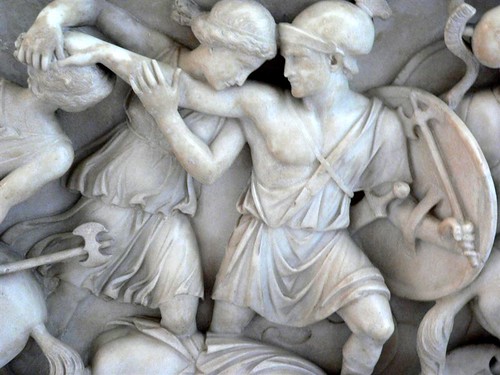Subsection of Roman Times:
A weblog of links to and abstracts from academic presentations on the Roman Empire
Sunday, March 11, 2007
David Parsons publishes fascinating blog for classicists
Silures revolt subject of new research

I found this article very interesting. I had not read about the Silures tribe and their quarter-century battle against the Romans. I'll have to look up Dr. Howell's book.
"A leading historian has documented the exploits of the ancient Silures tribe, who fought a long campaign against the Romans two millennia ago.
Dr Ray Howell from the University of Wales, Newport, even says our penchant for wearing red may spring from the tribe's favourite battle colour.
Dr Howell, a reader at the university's School of Education, has published an examination of the South-East Wales tribe, who came close to thwarting the Roman domination of southern Britain.
He said, "What emerges is not only a warrior society, but also a sophisticated people who traded widely and made good use of horses and horse-drawn vehicles...
They had war chariots with equestrian equipment decorated with red enamel. For the Silures the colour of war was emphatically red...
He believes the Silures tribe were more advanced than most people give them credit for, having waged a ferocious guerrilla campaign against the Romans which lasted far longer than even the famous Boudica-led revolt.
The Iron-Age tribe managed to defeat a whole Roman legion during their bloody campaign.
And even though their attacks from hill forts were eventually subdued after a quarter of a century, Dr Howell believes some of the culture of the tribe, which is likely to have spoken an extremely early form of Welsh, lived on after the Romans left Britain for good...
He believes there is still plenty more for archaeologists to discover about the civilisation, with just five of some 40 hill forts in Gwent having been explored."
Wednesday, March 07, 2007
The Louvre and the Ancient World to premiere in Atlanta

This sounds like a fascinating exhibit:
“The Louvre and the Ancient World,” features masterpieces from the founding cultures of Western civilization and will include more than 70 works from the Louvre’s unparalleled Egyptian, Near Eastern and Greco-Roman antiquities collections. Showcasing works dating from the third millennium BC through the third century AD, the exhibition will examine the rise of the museum and its collections of antiquities under Napoleon, the discoveries and decipherment of hieroglyphics and cuneiform and the Louvre’s leading role in excavating the cradle of civilization at the end of the nineteenth century and during the 20th century (most of the excavations for Near East).
The oldest works in the exhibition are drawn from the ancient cultures of Egypt, Susa (in modern Iran), the Neo-Sumerian city of Tello (in modern Iraq) and the Canaanite city of Ugarit (in modern Syria). Key works from these periods include the diorite “Statue of Wahibre, Governor of Upper Egypt” (Late period Egyptian); an Egyptian papyrus that belonged to the first Egyptian Museum whose curator, Jean-François Champollion, is credited with first deciphering hieroglyphics (Third Intermediate Period); an Attic black-figure amphora attributed to the potter Exekias (550–540 BC); and a dolerite “Statue of Gudea, Prince of Lagash” from Tello (Neo-Sumerian Period). A special installation will showcase the colossal, ten-foot-long “Tiber”—one of the largest sculptures in the Louvre’s collections. The statue personifies the Tiber River, Rome’s main trade artery. “The Louvre and the Ancient World” will be on view from October 16, 2007, through September 7, 2008."